turn signal TOYOTA HIGHLANDER 2020 Owners Manual (in English)
[x] Cancel search | Manufacturer: TOYOTA, Model Year: 2020, Model line: HIGHLANDER, Model: TOYOTA HIGHLANDER 2020Pages: 560, PDF Size: 14.42 MB
Page 2 of 560
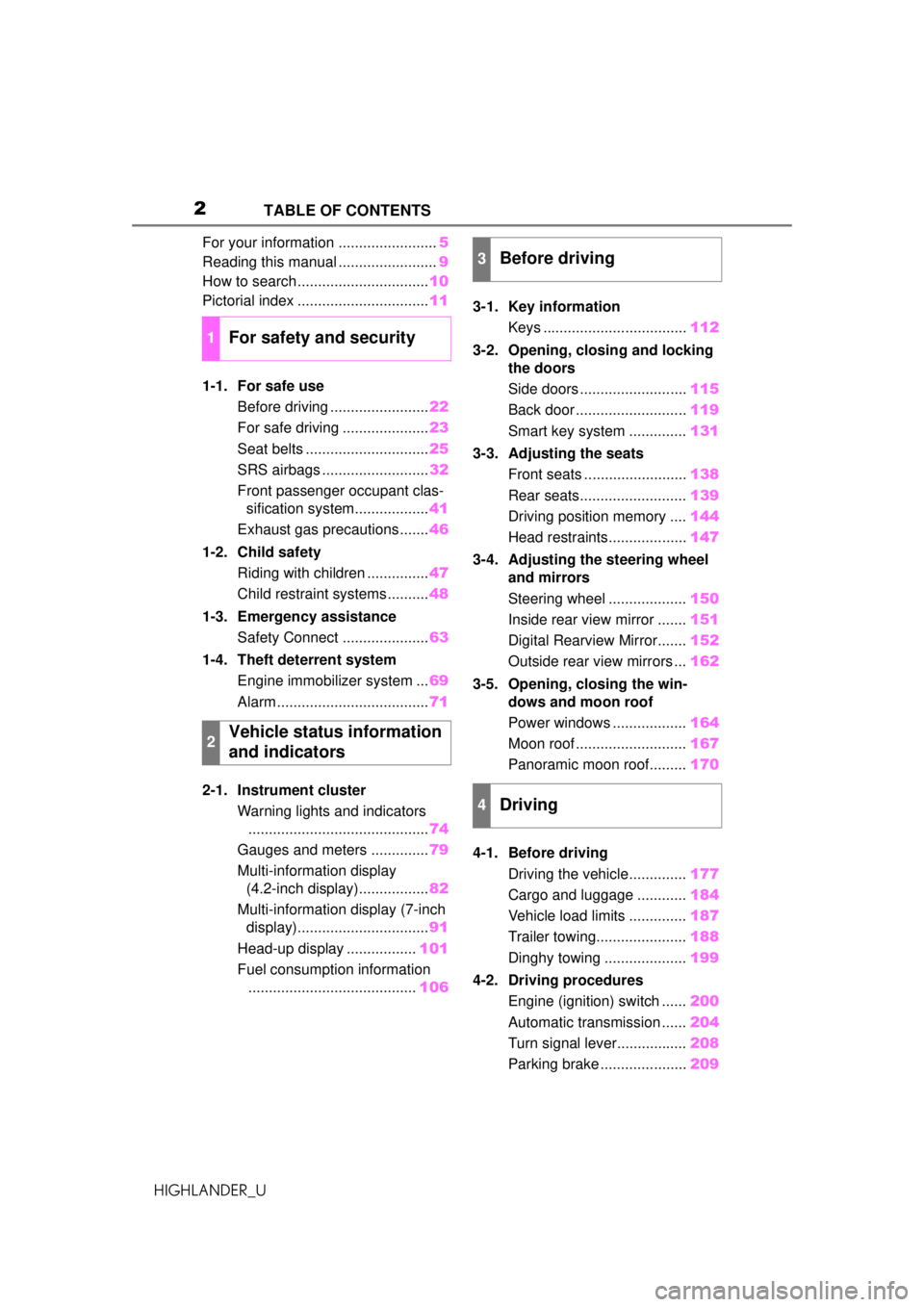
2
HIGHLANDER_UTABLE OF CONTENTS
For your information ........................
5
Reading this manual ........................ 9
How to search ................................ 10
Pictorial index ................................ 11
1-1. For safe use Before driving ........................ 22
For safe driving ..................... 23
Seat belts .............................. 25
SRS airbags .......................... 32
Front passenger occupant clas- sification system.................. 41
Exhaust gas precautions....... 46
1-2. Child safety Riding with children ............... 47
Child restraint systems .......... 48
1-3. Emergency assistance Safety Connect ..................... 63
1-4. Theft deterrent system Engine immobilizer system ... 69
Alarm ..................................... 71
2-1. Instrument cluster Warning lights and indicators............................................ 74
Gauges and meters .............. 79
Multi-information display (4.2-inch display)................. 82
Multi-information display (7-inch display)................................ 91
Head-up display ................. 101
Fuel consumption information ......................................... 1063-1. Key information
Keys ................................... 112
3-2.
Opening, closing and locking
th
e doors
Side doors .......................... 115
Back door ........................... 119
Smart key system .............. 131
3-3. Adjusting the seats Front seats ......................... 138
Rear seats.......................... 139
Driving position memory .... 144
Head restraints................... 147
3-4. Adjust
ing the steering wheel
and mirrors
Ste
ering wheel ...................150
Inside rear view mirror ....... 151
Digital Rearview Mirror....... 152
Outside rear view mirrors ... 162
3-5. Opening, closing the win- dows and moon roof
Power windows .................. 164
Moon roof ........................... 167
Panoramic moon roof......... 170
4-1. Before driving Driving the vehicle.............. 177
Cargo and luggage ............ 184
Vehicle load limits .............. 187
Trailer towing...................... 188
Dinghy towing .................... 199
4-2. Driving procedures Engine
(ignition) switch ...... 200
Automatic transmission ...... 204
Turn signal lever................. 208
Parking brake ..................... 209
1For safety and security
2Vehicle status information
and indicators
3Before driving
4Driving
Page 12 of 560

12Pictorial index
HIGHLANDER_U
Precautions for winter season.... .......................................... P.319
To prevent freezing (windshield wiper de-icer) ............. P.330, 335
Precautions for car wash
*.................................................... P.389
Fuel filler door .................................................................... P.225
Refueling method ................................................................. P.225
Fuel type/fuel tank capacity ................................................. P.495
Tires..................................................................................... P.411
Tire size/inflation pressure ........................................... P.411, 499
Winter tires/tire chains ......................................................... P.319
Checking/rotation/tire pressure warning system .................. P.411
Coping with flat tires............................................................. P.464
Hood .................................................................................... P.402
Opening ............................................................................... P.402
Engine oil ............................................................................. P.495
Coping with overheating ...................................................... P.487
Warning messages .............................................................. P.460
Headlights........................................................................... P.214
Parking lights ..................................................................... P.214
Front turn signal lights ...................................................... P.208
Parking lights
*/daytime running lights............................. P.214
Front side marker lights .................................................... P.214
Front fog lights
*.................................................................. P.220
Stop/tail lights .................................................................... P.214
Tail lights............................................................................. P.214
Back-up lights
Shifting the shift lever to R ................................................... P.204
License plate lights............................................................ P.214
Rear turn signal lights ....................................................... P.208
Light bulbs of the exterior lights for driving
(Replacing method: P.432, Watts: P.501)
Page 13 of 560

13Pictorial index
HIGHLANDER_U
Rear side marker lights ..................................................... P.214
Side turn signal lights ....................................................... P.208
*: If equipped
Page 15 of 560
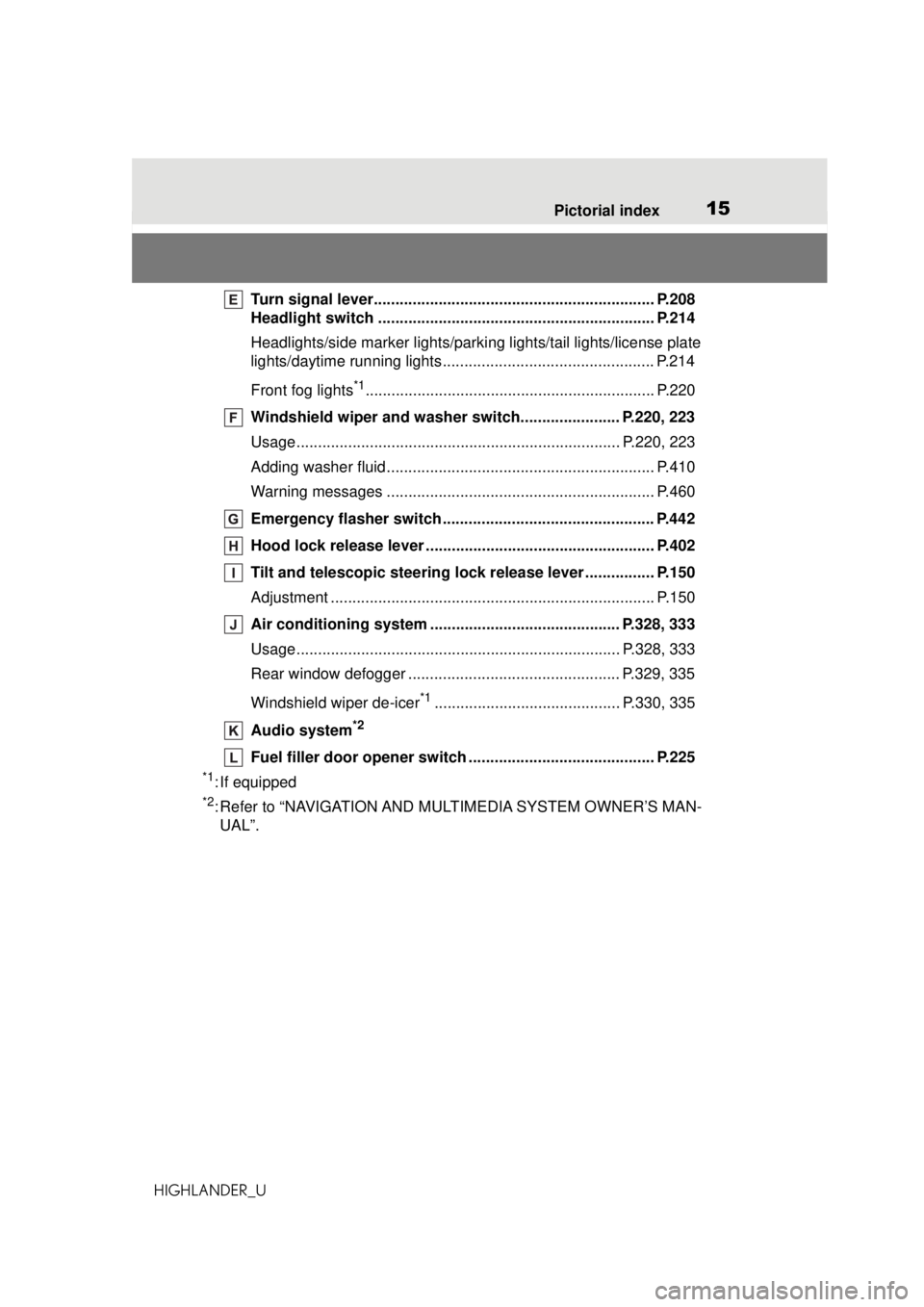
15Pictorial index
HIGHLANDER_U
Turn signal lever................................................................. P.208
Headlight switch ................................................................ P.214
Headlights/side marker lights/park ing lights/tail lights/license plate
lights/daytime running lights ................................................. P.214
Front fog lights
*1................................................................... P.220
Windshield wiper and washer switch....................... P.220, 223
Usage........................................................................... P.220, 223
Adding washer fluid .............................................................. P.410
Warning messages .............................................................. P.460
Emergency flasher switch ................................................. P.442
Hood lock releas e lever .............................................. ....... P.402
Tilt and telescopic steering lo ck release lever ................ P.150
Adjustment ........................................................................... P.150
Air conditioning system ................................. ........... P.328, 333
Usage........................................................................... P.328, 333
Rear window defogger ................................................. P.329, 335
Windshield wiper de-icer
*1........................................... P.330, 335
Audio system
*2
Fuel filler door opener switch ........................................... P.225
*1: If equipped
*2: Refer to “NAVIGATION AND MU LTIMEDIA SYSTEM OWNER’S MAN-
UAL”.
Page 77 of 560
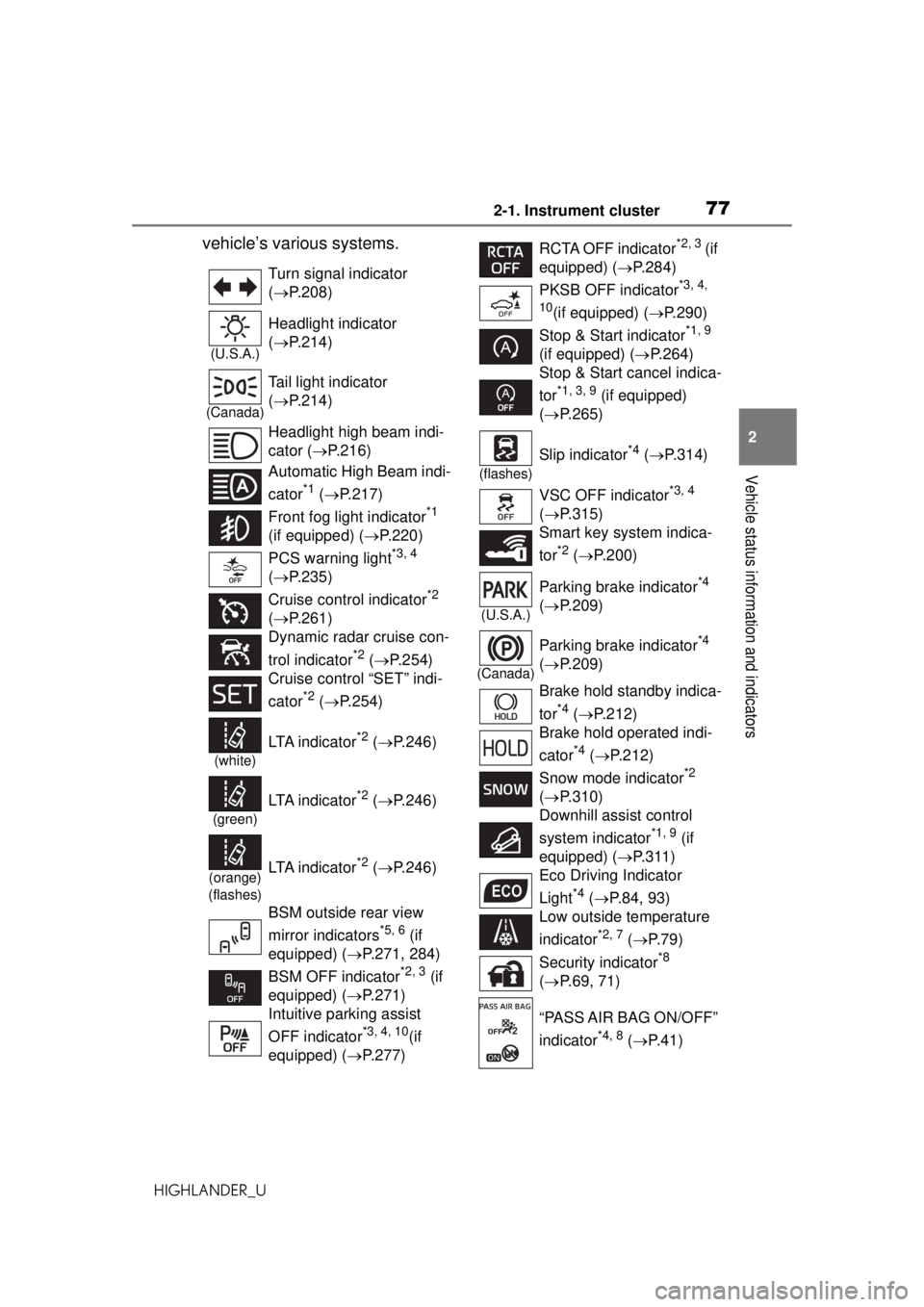
772-1. Instrument cluster
HIGHLANDER_U
2
Vehicle status information and indicators
vehicle’s various systems.
Turn signal indicator
( P.208)
(U.S.A.)
Headlight indicator
( P.214)
(Canada)
Tail light indicator
( P.214)
Headlight high beam indi-
cator ( P.216)
Automatic High Beam indi-
cator
*1 ( P.217)
Front fog light indicator
*1
(if equipped) ( P.220)
PCS warning light
*3, 4
( P.235)
Cruise control indicator
*2
( P.261)
Dynamic radar cruise con-
trol indicator
*2 ( P.254)
Cruise control “SET” indi-
cator
*2 ( P.254)
(white)
LTA i n d i c a t o r*2 ( P.246)
(green)
LTA i n d i c a t o r*2 ( P.246)
(orange)
(flashes)LTA i n d i c a t o r*2 ( P.246)
BSM outside rear view
mirror indicators
*5, 6 (if
equipped) ( P.271, 284)
BSM OFF indicator
*2, 3 (if
equipped) ( P.271)
Intuitive parking assist
OFF indicator
*3, 4, 10(if
equipped) ( P.277)
RCTA OFF indicator*2, 3 (if
equipped) ( P.284)
PKSB OFF indicator
*3, 4,
10
(if equipped) ( P.290)
Stop & Start indicator
*1, 9
(if equipped) ( P.264)
Stop & Start cancel indica-
tor
*1, 3, 9 (if equipped)
( P.265)
(flashes)
Slip indicator*4 ( P.314)
VSC OFF indicator
*3, 4
( P.315)
Smart key system indica-
tor
*2 ( P.200)
(U.S.A.)
Parking brake indicator*4
( P.209)
(Canada)
Parking brake indicator*4
( P.209)
Brake hold standby indica-
tor
*4 ( P.212)
Brake hold operated indi-
cator
*4 ( P.212)
Snow mode indicator
*2
( P.310)
Downhill assist control
system indicator
*1, 9 (if
equipped) ( P.311)
Eco Driving Indicator
Light
*4 ( P. 8 4 , 9 3 )
Low outside temperature
indicator
*2, 7 ( P. 7 9 )
Security indicator
*8
( P.69, 71)
“PASS AIR BAG ON/OFF”
indicator
*4, 8 ( P. 4 1 )
Page 175 of 560
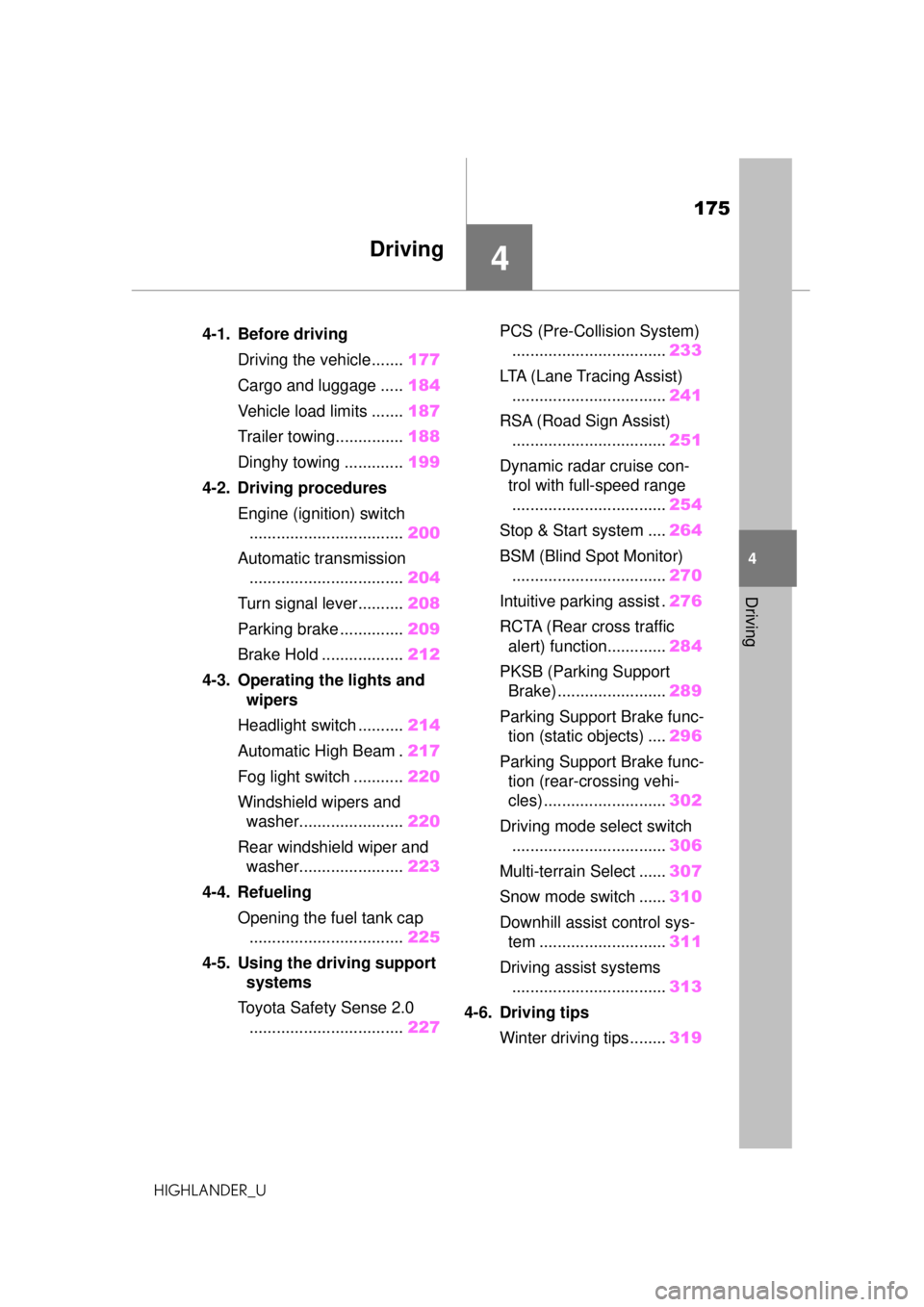
175
HIGHLANDER_U
4
4
Driving
Driving
.4-1. Before drivingDriving the vehicle....... 177
Cargo and luggage ..... 184
Vehicle load limits ....... 187
Trailer towing............... 188
Dinghy towing ............. 199
4-2. Driving procedures Engine (ignition) switch.................................. 200
Automatic transmission .................................. 204
Turn signal lever.......... 208
Parking brake .............. 209
Brake Hold .................. 212
4-3. Operating the lights and wipers
Headlight switch .......... 214
Automatic High Beam . 217
Fog light switch ........... 220
Windshield wipers and washer....................... 220
Rear windshield wiper and washer....................... 223
4-4. Refueling Opening the fuel tank cap.................................. 225
4-5. Using the driving support systems
Toyota Safety Sense 2.0 .................................. 227PCS (Pre-Collision System)
.................................. 233
LTA (Lane Tracing Assist) .................................. 241
RSA (Road Sign Assist) .................................. 251
Dynamic radar cruise con- trol with full-speed range.................................. 254
Stop & Start system .... 264
BSM (Blind Spot Monitor) .................................. 270
Intuitive parking assist . 276
RCTA (Rear cross traffic alert) function............. 284
PKSB (Parking Support Brake) ........................ 289
Parking Support Brake func- tion (static objects) .... 296
Parking Support Brake func- tion (rear-crossing vehi-
cles) ........................... 302
Driving mode select switch .................................. 306
Multi-terrain Select ...... 307
Snow mode switch ...... 310
Downhill assist control sys- tem ............................ 311
Driving assist systems .................................. 313
4-6. Driving tips Winter driving tips........ 319
Page 196 of 560
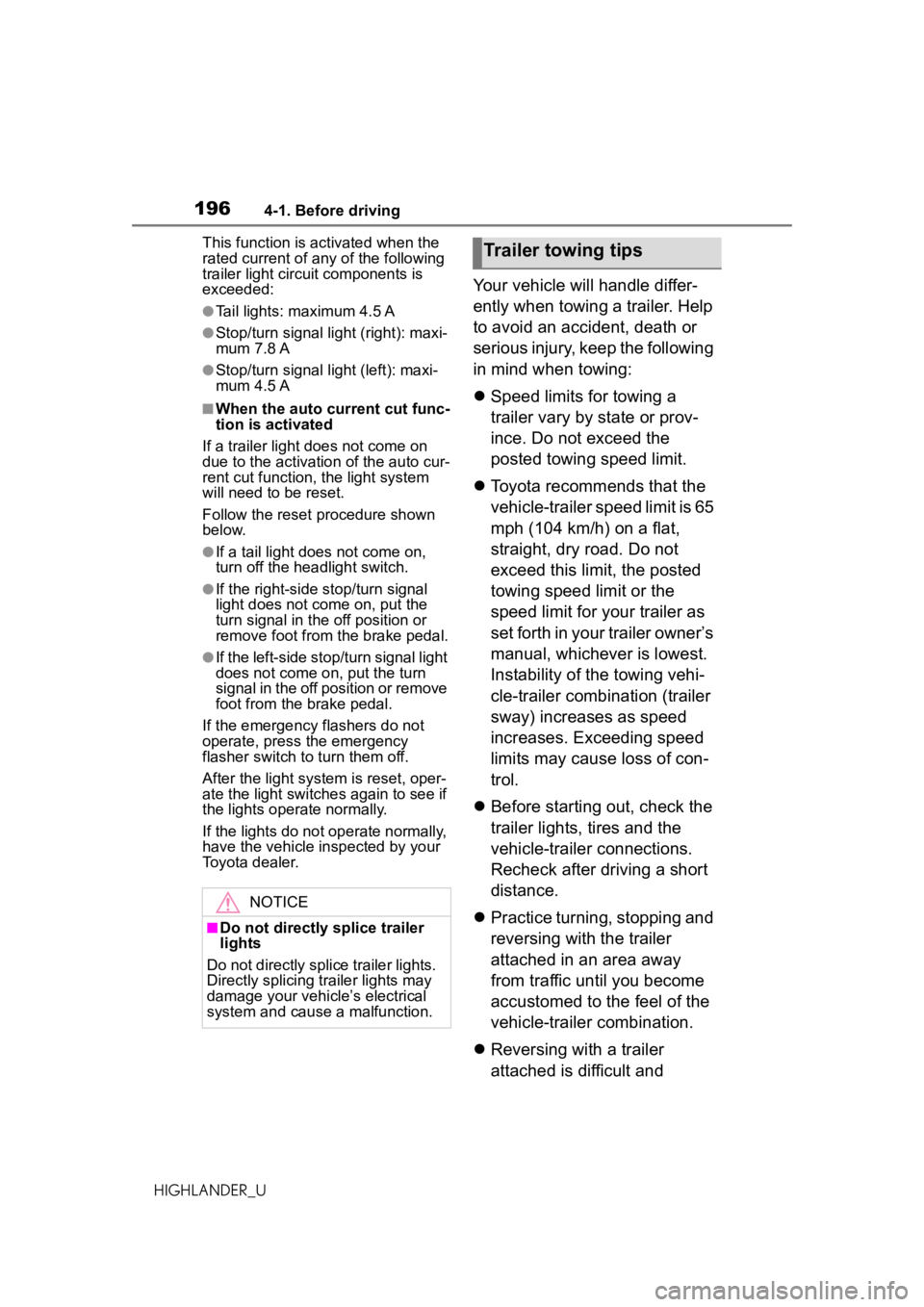
1964-1. Before driving
HIGHLANDER_UThis function is activated when the
rated current of any of the following
trailer light circuit components is
exceeded:
●Tail lights: maximum 4.5 A
●Stop/turn signal light (right): maxi-
mum 7.8 A
●Stop/turn signal light (left): maxi-
mum 4.5 A
■When the auto current cut func-
tion is activated
If a trailer light does not come on
due to the activation of the auto cur-
rent cut function, the light system
will need to be reset.
Follow the reset procedure shown
below.
●If a tail light does not come on,
turn off the headlight switch.
●If the right-side stop/turn signal
light does not come on, put the
turn signal in the off position or
remove foot from the brake pedal.
●If the left-side stop/turn signal light
does not come on, put the turn
signal in the off position or remove
foot from the brake pedal.
If the emergency flashers do not
operate, press the emergency
flasher switch to turn them off.
After the light system is reset, oper-
ate the light switches again to see if
the lights operate normally.
If the lights do not operate normally,
have the vehicle inspected by your
Toyota dealer.
Your vehicle will handle differ-
ently when towing a trailer. Help
to avoid an accident, death or
serious injury, keep the following
in mind when towing:
Speed limits for towing a
trailer vary by state or prov-
ince. Do not exceed the
posted towing speed limit.
Toyota recommends that the
vehicle-trailer speed limit is 65
mph (104 km/h) on a flat,
straight, dry road. Do not
exceed this limit, the posted
towing speed limit or the
speed limit for your trailer as
set forth in your trailer owner’s
manual, whichever is lowest.
Instability of the towing vehi-
cle-trailer combination (trailer
sway) increases as speed
increases. Exceeding speed
limits may cause loss of con-
trol.
Before starting out, check the
trailer lights, tires and the
vehicle-trailer connections.
Recheck after driving a short
distance.
Practice turning, stopping and
reversing with the trailer
attached in an area away
from traffic until you become
accustomed to the feel of the
vehicle-trailer combination.
Reversing with a trailer
attached is difficult and
NOTICE
■Do not directly splice trailer
lights
Do not directly splice trailer lights.
Directly splicing trailer lights may
damage your vehicle’s electrical
system and cause a malfunction.
Trailer towing tips
Page 208 of 560
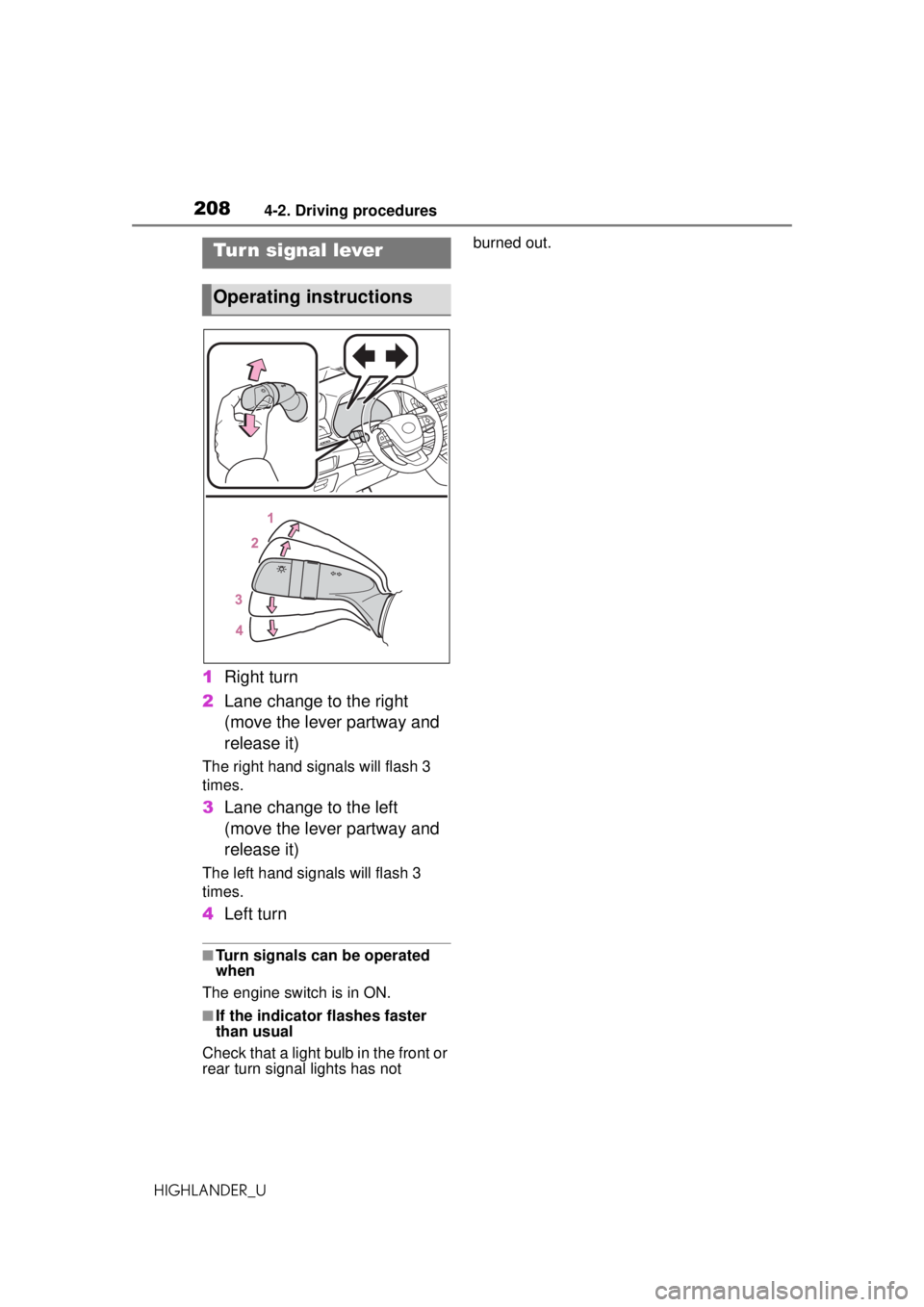
2084-2. Driving procedures
HIGHLANDER_U
1Right turn
2 Lane change to the right
(move the lever partway and
release it)
The right hand signals will flash 3
times.
3Lane change to the left
(move the lever partway and
release it)
The left hand signals will flash 3
times.
4Left turn
■Turn signals can be operated
when
The engine switch is in ON.
■If the indicator flashes faster
than usual
Check that a light bulb in the front or
rear turn signal lights has not burned out.
Tur n signal lever
Operating instructions
Page 218 of 560

2184-3. Operating the lights and wipers
HIGHLANDER_Ufrom around a curve
• When the vehicle is cut in front of by another vehicle
• When vehicles ahead cannot be detected due to repeated curves,
road dividers or roadside trees
• When vehicles ahead appear in a faraway lane on a wide road
• When the lights of vehicles ahead
are not on
●The high beams may be turned off
if a vehicle ahead that is using fog
lights without its headlights turned
on is detected.
●House lights, street lights, traffic
signals, and illumi nated billboards
or signs and other reflective
objects may cause the high
beams to change to the low
beams, or the low beams to
remain on.
●The following factors may affect
the amount of time taken for the
high beams to turn on or off:
• The brightness of the headlights, fog lights, and tail lights of vehi-
cles ahead
• The movement and direction of vehicles ahead
• When a vehicle ahead only has
operational lights on one side
• When a vehicle ahead is a two-wheeled vehicle
• The condition of the road (gradi- ent, curve, condition of the road
surface, etc.)
• The number of passengers and amount of luggage in the vehicle
●The high beams may turn on or off
unexpectedly.
●Bicycles or similar vehicles may
not be detected.
●In the following situations the sys-
tem may not be able to correctly
detect the surrounding brightness
level. This may cause the low
beams to remain on or the high
beams to flash or dazzle pedestri-
ans or vehicles ahead. In such a
case, it is necess ary to manually
switch between the high and low
beams. • When driving in inclement weather
(heavy rain, snow, fog, sand-
storms, etc.)
• When the windshield is obscured by fog, mist, ice, dirt, etc.
• When the windshield is cracked or
damaged
• When the camera sensor is deformed or dirty
• When the temperature of the cam- era sensor is extremely high
• When the surrounding brightness
level is equal to that of headlights,
tail lights or fog lights
• When headlights or tail lights of
vehicles ahead are turned off,
dirty, changing color, or not aimed
properly
• When the vehicle is hit by water, snow, dust, etc. from a preceding
vehicle
• When driving through an area of intermittently changing brightness
and darkness
• When frequently and repeatedly driving ascending/descending
roads, or roads with rough, bumpy
or uneven surfaces (such as
stone-paved roads, gravel roads,
etc.)
• When frequently and repeatedly taking curves or driving on a wind-
ing road
• When there is a highly reflective object ahead of the vehicle, such
as a sign or mirror
• When the back of a preceding vehicle is highly reflective, such as
a container on a truck
• When the vehicle’s headlights are damaged or dirty, or are not aimed
properly
• When the vehicle is listing or titling due to a flat tire, a trailer being
towed, etc.
• When the headlights are changed between the high beams and low
beams repeatedly in an abnormal
manner
• When the driver believes that the high beams may be flashing or
dazzling pedestrians or other driv-
ers
Page 244 of 560

2444-5. Using the driving support systems
HIGHLANDER_U
■Lane departure alert func-
tion
When the system determines
that the vehicle might depart
from its lane or course
*, a warn- ing is displayed on the
multi-information display, and a
warning buzzer will sound to
alert the driver.
When the warning buzzer sounds,
check the area around your vehicle
and carefully operate the steering
wheel to move the vehicle back to
the center of the lane.
Vehicle with BSM: When the sys-
tem determines that the vehicle
might depart from its lane and that
the possibility of a collision with an
overtaking vehicle in the adjacent
lane is high, the lane departure
alert will operate even if the turn
signals are operating.
*: Boundary between asphalt and
the side of the road, such as
grass, soil, or a curb
■Steering assist function
When the system determines
that the vehicle might depart
from its lane or course
*, the sys-
WARNING
●The traffic lane is excessively
narrow or wide.
●The vehicle is extremely tilted
due to carrying heavy luggage
or having improper tire pres-
sure.
●The distance to the preceding
vehicle is extremely short.
●The vehicle is moving up and
down a large amount due to
road conditions during driving
(poor roads or road seams).
●When driving in a tunnel or at
night with the headlights off or
when a headlight is dim due to
its lens being dirty or it being
misaligned.
●The vehicle is struck by a cross-
wind.
●The vehicle is affected by wind
from a vehicle driven in a
nearby lane.
●The vehicle has just changed
lanes or crossed an intersec-
tion.
●Tires which differ by structure,
manufacturer, brand or tread
pattern are used.
●Snow tires, etc. are equipped.
●The vehicle is being driven at
extremely high speeds.
Functions included in LTA
system